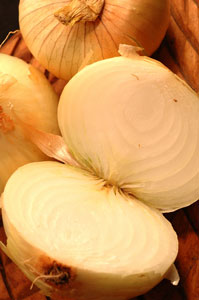Vadalia
|
|
The intense sweetness of a Vidalia onion is due in part to low sulfur content, a mild growing season, and sandy soil.
|
Their worldwide popularity is attributed to carefully controlled growing conditions and a sweet, fresh taste.
History
The Vidalia onion made its first recognized appearance in 1931. A farmer, Moses Coleman, was surprised by a fresh crop of onions that were not hot, but intensely sweet. A few years later, the onions became one of the stars of the Vidalia, , farmers’ market and word spread.
Today, it is the state vegetable and proudly protected by Federal law.
Buying Tips
Like most sweet summer onions, Vidalias are available from late spring to mid-fall. Check the produce section as these onions will be specially marked “Certified Sweet Vidalia.”
Storage Tips
• Due to their dense water and sugar content, these onions should be handled carefully to avoid bruising. To remain fresh, they must have plenty of cool, dry space without touching one another. Flavors from other food products can be absorbed.
• Before refrigerating, wrap each onion in a paper towel.
• Freeze them whole or sliced. The texture will change, making them usable only for cooking.
Usage Tips
• Vidalia onions are superb in fresh salads and sliced for sandwiches. They can also be grilled, baked, and sautéed.
• To heighten the sugary effect in a sweet onion, place slices in a bowl of ice water for about half an hour before using.
• Avoid overcooking to preserve the Vidalia’s “personality.”
Substitution Tips
• 2 teaspoons onion powder = 1 medium onion
• 2 tablespoon onion flakes = 1 medium onion
When using in casseroles or other dishes that require a longer cooking time, use any storage onion.
Try one of our favorite Vidalia onion recipes:
Baked Vidalia Onions
Taltys Red Sauce
Roasted And Smoked Sweet Onions






